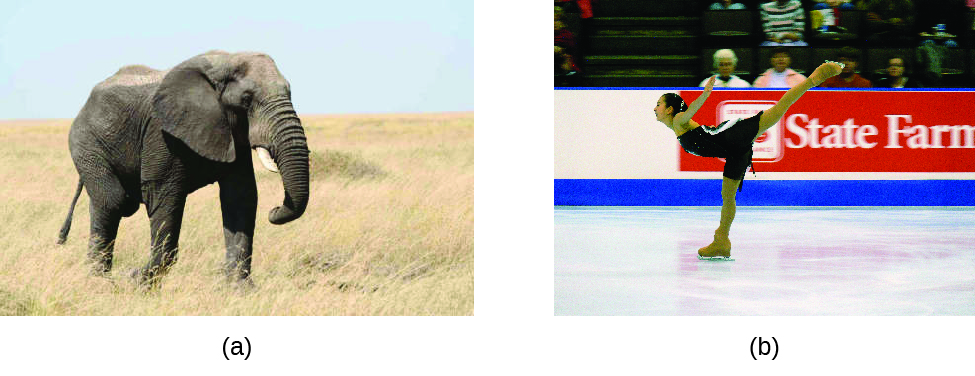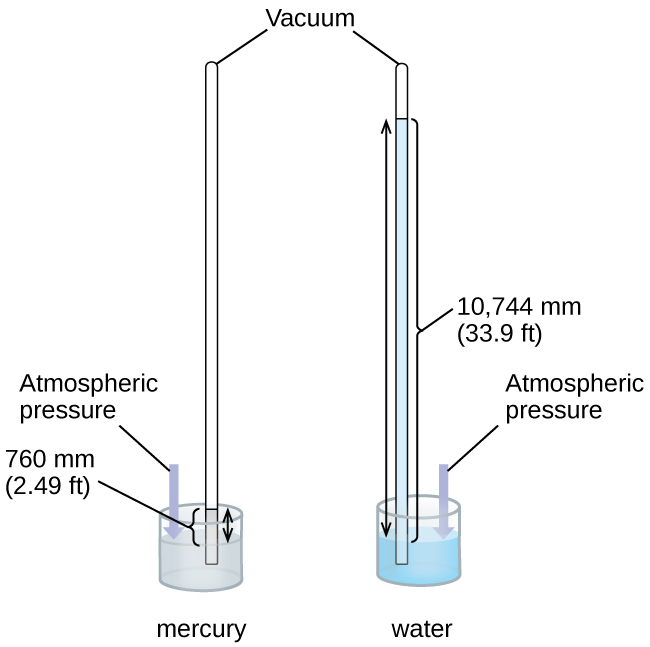Gas pressure is caused by the force exerted by gas molecules colliding with the surfaces of objects. Although the force of each collision is very small, any surface of appreciable area experiences a large number of collisions in a short time, which can result in a high pressure. In fact, normal air pressure is strong enough to crush a metal container when not balanced by equal pressure from inside the container.
A dramatic illustration of atmospheric pressure is provided in this brief video, which shows a railway tanker car imploding when its internal pressure is decreased.
A smaller scale demonstration of this phenomenon is briefly explained in this news segment.
Atmospheric pressure is caused by the weight of the column of air molecules in the atmosphere above an object, such as the tanker car. At sea level, this pressure is roughly the same as that exerted by a full-grown African elephant standing on a doormat, or a typical bowling ball resting on your thumbnail. These may seem like huge amounts, and they are, but life on earth has evolved under such atmospheric pressure. If you actually perch a bowling ball on your thumbnail, the pressure experienced is twice the usual pressure, and the sensation is unpleasant.
In general, pressure is defined as the force exerted on a given area: $P=\frac{F}{A}$. Note that pressure is directly proportional to force and inversely proportional to area. Thus, pressure can be increased either by increasing the amount of force or by decreasing the area over which it is applied; pressure can be decreased by decreasing the force or increasing the area.
The SI unit for pressure is the pascal (Pa), which is defined as $ \frac{kg}{m \cdot s^2} $ in base units.
Who exerts the most pressure?
Who would be most likely to fall through thin ice – an elephant or a figure skater?
An African elephant can weigh from ~2000 to 6300 kg. An elephant’s foot has a diameter of about 45 cm. Taking the larger mass, and calculating the area of their foot as a circle: $$\text{Area of foot}=\pi r^2 = \pi \times \left( \frac{0.45 \; \text{m}}{2}\right)^2 = 0.16\; \text{m}^2 \; \text{per foot}$$ Pressure is force over area, where in this case “force” is the gravitational force on the mass of the elephant. (Also remember that elephants have four feet!). Physical constants are found in the Appendix: $$F = mg\quad \text{and} \quad P = \frac{F}{\text{Area}}\\ P = \frac{6300\; \text{kg}\times 9.8067 m/s^2}{4\times 0.16 m^2}\\ P = 96534.7 \frac{\text{kg}}{\text{m s}^2} = 96534.7\;\text{Pa} = 97\; \text{kPa} $$
A typical female figure skater as shown above could weigh about 55 kg, and is supported on two skate blades, each with a contact area of about 6.5 cm2. The pressure exerted over her skates is: $$F = mg\quad \text{and} \quad P = \frac{F}{\text{Area}}\\ P = \frac{55\; \text{kg}\times 9.8067 m/s^2}{2\times 6.5\; \text{cm}^2 \times \frac{1\; \text{m}^2}{(100)^2 \text{cm}^2}}\\ P = 414898.8\; \text{Pa} = 415\;\text{kPa}$$
Even though the elephant weighs much more than the skater, that force is distributed over a wider area, so it would be less likely to fall through ice (or sink in mud, etc). If the skater stood in regular footwear rather than skates (increasing her contact area to about 150 cm2 per foot), she would exert a pressure of only 18 kPa.
While the SI unit of pressure is the pascal, many non-standard units are also in common use:
Pressure Units
| Unit Name and Abbreviation | Definition or Relation to Other Unit |
|---|---|
| pascal (Pa) | 1 Pa = 1 N/m2 recommended IUPAC unit |
| kilopascal (kPa) | 1 kPa = 1000 Pa |
| pounds per square inch (psi) | 1 psi = ~6895 Pa |
| atmosphere (atm) | 1 atm = 101,325 Pa = 760 torr = 1.01325 bar (exactly) air pressure at sea level is ~1 atm |
| bar (bar, or b) | 1 bar = 100,000 Pa (exactly) commonly used in meteorology, air pressure at sea level is also ~1 bar |
| inches of mercury (in. Hg) | 1 in. Hg = ~3386 Pa |
| torr | $1 torr=\frac{1}{760}$ atm (exactly) (named after Evangelista Torricelli, inventor of the barometer) |
| millimeters of mercury (mm Hg) | 1 mm Hg = 133.322387415 Pa (exactly) |
Conversion of Pressure Units
The United States National Weather Service reports pressure in both inches of Hg and millibars. Convert a pressure of 29.2 in. Hg into:
(a) torr
(b) atm
(c) kPa
(d) mbar
Solution
This is a unit conversion problem. The relationships between the various pressure units are given in the table above.
(a) $29.2\require{enclose}\enclose{horizontalstrike}{in\;Hg}\times\frac{25.4\enclose{horizontalstrike}{mm}}{1\enclose{horizontalstrike}{in}}\times\frac{1\;torr}{1\enclose{horizontalstrike}{mm\;Hg}}=742\;torr$
(b) $742\enclose{horizontalstrike}{torr}\times\frac{1\;\enclose{horizontalstrike}{atm}}{760\;\enclose{horizontalstrike}{torr}}=0.976\;atm$
(c) $742\enclose{horizontalstrike}{torr}\times\frac{101.325\;kPa}{760\;\enclose{horizontalstrike}{torr}}=98.9\;kPa$
(d) $98.9\;\enclose{horizontalstrike}{kPa}\times\frac{1000\;\enclose{horizontalstrike}{Pa}}{1\;\enclose{horizontalstrike}{kPa}}\times\frac{1\;\enclose{horizontalstrike}{bar}}{100,000\;\enclose{horizontalstrike}{Pa}}\times\frac{1000\;mbar}{1\;\enclose{horizontalstrike}{bar}}=989\;mbar$
Check Your Learning
A typical barometric pressure in Kansas City is 740 torr. What is this pressure in atmospheres, in millimeters of mercury, in kilopascals, and in bar?
Answer
0.974 atm; 740 mm Hg; 98.7 kPa; 0.987 bar
We can measure atmospheric pressure, the force exerted by the atmosphere on the earth’s surface, with a barometer. A barometer is a glass tube that is closed at one end, filled with a nonvolatile liquid such as mercury, and then inverted and immersed in a container of that liquid. The atmosphere exerts pressure on the liquid outside the tube, the column of liquid exerts pressure inside the tube, and the pressure at the liquid surface is the same inside and outside the tube. The height of the liquid in the tube is therefore proportional to the pressure exerted by the atmosphere.

If the liquid is water, normal atmospheric pressure will support a column of water over 10 meters high, which is rather inconvenient for making (and reading) a barometer. Because mercury (Hg) is about 13.6-times denser than water, a mercury barometer only needs to be $\frac{1}{13.6}$ as tall as a water barometer—a more suitable size. Standard atmospheric pressure of 1 atm at sea level (101,325 Pa) corresponds to a column of mercury that is about 760 mm high. The torr was originally intended to be a unit equal to one millimeter of mercury, but it no longer corresponds exactly. The pressure exerted by a fluid due to gravity is known as hydrostatic pressure, p:
$$p=h\rho g$$where h is the height of the fluid, ρ is the density of the fluid, and g is acceleration due to gravity.
Calculation of Barometric Pressure
Show the calculation supporting the claim that atmospheric pressure near sea level corresponds to the pressure exerted by a column of mercury that is about 760 mm high. The density of mercury = 13.6 g/cm3.
SolutionThe hydrostatic pressure is given by p = hρg, with h = 760 mm, ρ = 13.6 g/cm3, and g = 9.81 m/s2. Plugging these values into the equation and doing the necessary unit conversions will give us the value we seek. (Note: We are expecting to find a pressure of ~101,325 Pa.)
$$p=h\rho g \\ p=\left(760\;mm\times\frac{1\;m}{1000\;mm}\right)\times\left(\frac{13.6\;g}{1\;cm^3}\times\frac{1\;kg}{1000\;g}\times\frac{(100\;cm)^3}{(1\;m)^3}\right)\times\left(\frac{9.81\;m}{1\;s^2}\right)$$ $$=(0.760\;m)(13,600\;kg/m^3)(9.81\;m/s^2)=1.01×10^5\;kg/ms^2$$ $$\mathbf{=1.01×10^5\;Pa}$$Check Your Learning
Calculate the height of a column of water at 25 °C that corresponds to normal atmospheric pressure. The density of water at this temperature is 1.0 g/cm3.
Answer
10.3 m